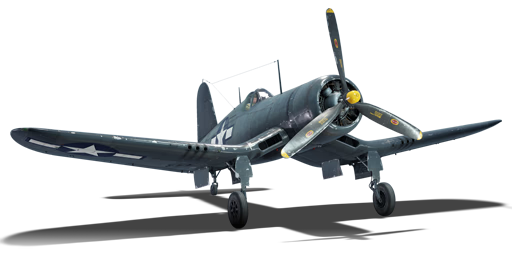



When the first F4U Corsairs were accepted in naval aviation services, the low visibility offered by its design caused complications in carrier landing, thus it was relegated to land operations among units like the United States Marine Corps Squadrons. Back in the factories, the F4U continued to be improved as user's experience and technology trickled into the design. This led to the installation of a more powerful Double Wasp engine, and accommodations for more ordnance as rockets and bombs that could be carried for the ground attack role, as well as being able to use external fuel tanks for extra range. The improved Corsair, designated the F4U-1D as produced by Vought, or FG-1D as produced by Goodyear, came in right as the US Navy began to accept the F4U Corsair for carrier operations. The first US Corsair squadron based on a carrier would be the USMC VMF-214 on the USS Essex with F4U-1Ds in December 1944. The F4U-1Ds would see service for the remainder of the war, even as improved Corsairs continued coming in.
The F4U-1D, introduced since the start of the Open Beta Test prior to Update 1.27, does not have many external differences from the F4U-1A. Despite the more powerful engine, the F4U-1D actually has lower maximum speed in comparison to its predecessor due to additional drags from its modifications. However, the ability to mount rockets and bombs onto the F4U-1D makes it more versatile to a changing battlefield, able to assist allies by blasting away lightly armoured foes with its rockets or with precision bomb strikes in a dive. In the air-to-air role, like its predecessor, play to its strength as an energy fighter by climbing and then performing boom-n-zoom attacks on your opponents, use the F4U-1D's greater maximum speed to escape from opponents before they have a chance to retaliate.
flaps
flaps
flaps
brake
| Belt | Belt filling | Armor penetration (mm) at a distance: | |||||
|---|---|---|---|---|---|---|---|
| 10 m | 100 m | 500 m | 1000 m | 1500 m | 2000 m | ||
| T/Ball/Ball/I/AP-I | 28 | 26 | 18 | 11 | 7 | 4 | |
| AP-I/AP-I/AP-I/T/I | 28 | 26 | 18 | 11 | 7 | 4 | |
| T/AP/AP/AP/AP-I/I | 30 | 27 | 20 | 13 | 9 | 6 | |
| T/T/T/T/T/AP-I | 28 | 26 | 18 | 11 | 7 | 4 | |
| AP/AP-I/AP-I/I/I | 30 | 27 | 20 | 13 | 9 | 6 | |












Flight performance | |
|---|---|
Survivability |
|---|
Weaponry | |
|---|---|